Click on images to enlarge
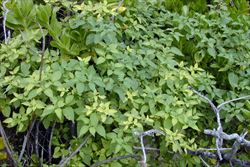
infestation (Photo: Forest and Kim Starr, USGS)
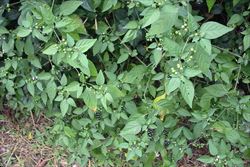
habit (Photo: Sheldon Navie)
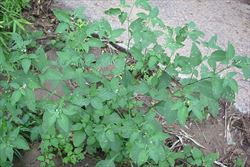
habit (Photo: Sheldon Navie)
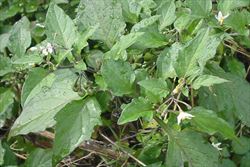
slightly-lobed lower leaves (Photo: Sheldon Navie)
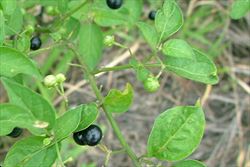
smaller, almost entire, upper leaves (Photo: Sheldon Navie)
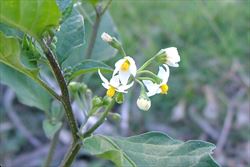
close-up of stem and flower cluster (Photo: Sheldon Navie)
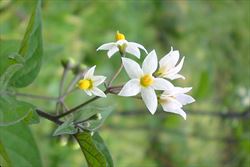
close-up of star-shaped flowers (Photo: Sheldon Navie)
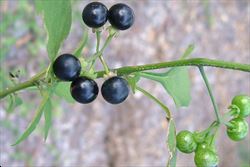
clusters of immature and mature fruit with backwards-pointing sepals (Photo: Sheldon Navie)
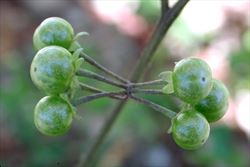
close-up of the glossy immature fruit, all spreading from the same point (Photo: Sheldon Navie)
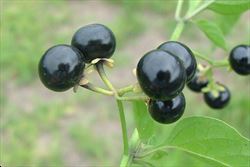
close-up of glossy black mature fruit (Photo: Sheldon Navie)
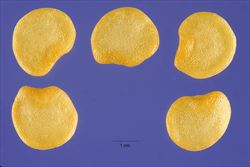
close-up of seeds (Photo: Steve Hurst at USDA PLANTS Database)
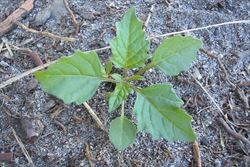
young plant (Photo: Sheldon Navie)
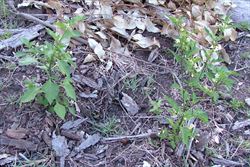
comparison of the very similar blackberry nightshade (Solanum nigrum), on the left, and glossy nightshade (Solanum americanum), on the right (Photo: Sheldon Navie)
Scientific Name
Solanum nodiflorum Jacq.
Synonyms
Solanum americanum Mill.
Solanum americanum Mill. subsp. nodiflorum (Jacq.) R.J.F. Hend.
Solanum americanum Mill. subsp. nutans (R.J.F. Hend.) R.J.F. Hend.
Solanum americanum Mill. var. nodiflorum (Jacq.) Edmonds
Solanum astroites G. Forst. (misapplied)
Solanum oleraceum Dunal ex Poir.
Solanum nigrum L. (misapplied)
Solanum nigrum L. var. pterocaulum Domin (misapplied)
Solanum nodiflorum Jacq. subsp. nodiflorum
Solanum nodiflorum Jacq. subsp. nutans R.J.F. Hend.
Solanum pterocaulum Dunal (misapplied)
Family
Solanaceae
Common Names
American black nightshade, American nightshade, black nightshade, common nightshade, garden nightshade, glossy nightshade, nightshade, small-flowered nightshade, small-flowered white nightshade
Origin
Glossy nightshade is very widespread throughout the world (i.e. cosmopolitan) and its exact native range is obscure. However, it is thought to be native to parts of North America (i.e. southern and western USA and Mexico), Central America (i.e. Costa Rica, El Salvador, Guatemala, Honduras, Nicaragua and Panama), the Caribbean and South America (i.e. French Guiana, Guyana, Surinam, Venezuela, Brazil, Bolivia, Colombia, Ecuador, Peru and Paraguay).
Naturalised Distribution
This species is very widespread in the wetter parts of northern, eastern and western Australia. It is most common in the coastal and sub-coastal districts of eastern Queensland, eastern New South Wales and southern Victoria. Also relatively common in the coastal districts of south-western Western Australia and scattered in the northern parts of the Northern Territory and in northern Western Australia. Also recorded in other parts of these states, sparingly naturalised in Tasmania, and present on several offshore islands (i.e. Lord Howe Island, Norfolk Island, Christmas Island and the Cocos Islands).
Habitat
A very common weed of crops, gardens, parks, footpaths, pastures, forest margins, roadsides, disturbed sites and waste areas in tropical, sub-tropical and warmer temperate regions.
Habit
A short-lived (i.e. annual or short-lived perennial) herbaceous plant or small shrub growing up to 1.3 m or more tall. It is usually upright (i.e. erect) in habit, but plants may become spreading with age.
Distinguishing Features
- A short-lived herbaceous plant or small shrub growing up to 1.3 m or more tall.
- The rough stems and leaves are mostly hairless.
- The small star-shaped flowers are borne in umbell-like clusters in the upper leaf forks.
- The flowers have five white petals and five yellow stamens with anthers 1-1.6 mm long.
- The calyx is recurved in fruit
- Its fruit are glossy green when young, turning black or purplish-black and remaining glossy as they mature.
Stems and Leaves
The greenish younger stems are hairless (i.e. glabrous) or only sparsely hairy (i.e. puberulent) and sometimes tinged with purple. They are generally rough in texture and sometimes also slightly angled.
The alternately arranged leaves (2-14 cm long and 1-8 cm wide) are borne on stalks (i.e. petioles) 1-5 cm long. Their leaf blades are oval (i.e. elliptic), egg-shaped in outline (i.e. ovate) or elongated in shape (i.e. lanceolate) and taper to a point at the tip (i.e. acute or acuminate apex). The margins of the leaves are often entire, but can also be bluntly toothed (i.e. crenate) or shallowly lobed (i.e. sinuate), particularly on younger plants.
Flowers and Fruit
The small star-shaped flowers (8-9 mm across) are borne in clusters of 4-12 flowers in the upper leaf forks (i.e. axils). The main stalk of each cluster (i.e. peduncle) is 10-25 mm long, and each of the flowers is borne on a smaller stalk (i.e. pedicel) 5-8 mm long. These stalks all spread from about the same point (i.e. the flowers are arranged in umbelliform cymes). Each flower has five tiny sepals (1-2 mm long) and have five white petals (occasionally tinged with purple) that are recurved in fruit. The petals (8-9 mm long) are fused together at the base and the flowers have a yellow-green centre. Each flower also has five stamens, with yellow anthers (1-1.6 mm long) and an ovary topped with a style (2.5-4 mm long) and stigma. Flowering occurs throughout the year, but mainly from autumn through to spring.
The rounded fruit (i.e. globular berries) turn from green to black or purplish-black in colour as they mature. These fruit (6-9 mm across) are usually very glossy in appearance and are borne in a relatively upright position. Their stalks (i.e. pedicels) become elongated (up to 4 cm long) are their sepals become enlarged and are often bent backwards (i.e. reflexed). Each of these fleshy fruit contains numerous flattened seeds (1-1.5 mm long).
Reproduction and Dispersal
This species reproduces mainly by seed, which are most often spread by birds and other animals that eat the fruit.
Environmental Impact
Glossy nightshade (Solanum nodiflorum) is sometimes regarded as an environmental weed in Western Australia, the Northern Territory, Queensland and Victoria.
Legislation
Not declared or considered noxious by any state government authorities.
Similar Species
Glossy nightshade (Solanum nodiflorum) is very similar to blackberry nightshade (Solanum nigrum). However, blackberry nightshade (Solanum nigrum) can typically be distinguished by its dull fruit with smaller outward pointing or recurved sepals. Its flowers are also arranged in slightly elongated clusters, and its fruit are generally borne pointing downwards. The stamens are 1-1.6 mm long.
Glossy nightshade (Solanum nodiflorum) is also similar to hairy nightshade (Solanum chenopodioides), cherry nightshade (Solanum physalifolium var. nitidibaccatum) and the native greenberry nightshade (Solanum opacum). These species can be distinguished by the following differences:
- glossy nightshade (Solanum americanum) has almost hairless leaves and stems. Its fruit are usually very glossy in appearance and turn black or purplish-black as they mature.
- hairy nightshade (Solanum chenopodioides) has very hairy leaves and stems. Its fruit are dull in appearance and turn black as they mature.
- cherry nightshade (Solanum physalifolium var. nitidibaccatum) has somewhat hairy leaves and stems. Its fruit are usually glossy in appearance and green to purplish green when mature.
- greenberry nightshade (Solanum opacum) has somewhat hairy leaves and stems. Its fruit are usually glossy in appearance and are green or whitish-green when mature.
Note: For a more in-depth key to distinguish between all of the solanums (Solanum spp.) present in eastern Australia, see the online key to the Solanum Species of Eastern Australia at http://delta-intkey.com/solanum/index.htm.

